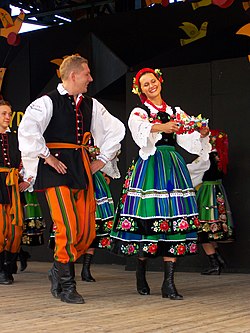Mazowszanie(Polish) | |
|---|---|
 | |
| Regions with significant populations | |
| Poland (Masovian Voivodeship) | |
| Languages | |
| Polish (Masovian dialect) | |
| Religion | |
| Roman Catholicism | |
| Related ethnic groups | |
| Poles, Masurians, Podlachians |

Masovians, [a] also spelled as Mazovians, and historically known as Masurians, [b] is an ethnographic group of Polish people that originates from the region of Masovia, located mostly within borders of the Masovian Voivodeship, Poland. They speak the Masovian dialect of Polish. [1] [2]
Contents
The group originates[ citation needed ] from the Lechitic tribe of Masovians, first referenced in the historical records by Nestor the Chronicler in the 11th century. [3]
In the Polish census of 2021, 97 people declared Mazovian national identity. [4]

